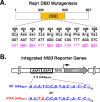Identification of a transcriptional activation domain in yeast repressor activator protein 1 (Rap1) using an altered DNA-binding specificity variant
- PMID: 28196871
- PMCID: PMC5392566
- DOI: 10.1074/jbc.M117.779181
Identification of a transcriptional activation domain in yeast repressor activator protein 1 (Rap1) using an altered DNA-binding specificity variant
Abstract
Repressor activator protein 1 (Rap1) performs multiple vital cellular functions in the budding yeast Saccharomyces cerevisiae These include regulation of telomere length, transcriptional repression of both telomere-proximal genes and the silent mating type loci, and transcriptional activation of hundreds of mRNA-encoding genes, including the highly transcribed ribosomal protein- and glycolytic enzyme-encoding genes. Studies of the contributions of Rap1 to telomere length regulation and transcriptional repression have yielded significant mechanistic insights. However, the mechanism of Rap1 transcriptional activation remains poorly understood because Rap1 is encoded by a single copy essential gene and is involved in many disparate and essential cellular functions, preventing easy interpretation of attempts to directly dissect Rap1 structure-function relationships. Moreover, conflicting reports on the ability of Rap1-heterologous DNA-binding domain fusion proteins to serve as chimeric transcriptional activators challenge use of this approach to study Rap1. Described here is the development of an altered DNA-binding specificity variant of Rap1 (Rap1AS). We used Rap1AS to map and characterize a 41-amino acid activation domain (AD) within the Rap1 C terminus. We found that this AD is required for transcription of both chimeric reporter genes and authentic chromosomal Rap1 enhancer-containing target genes. Finally, as predicted for a bona fide AD, mutation of this newly identified AD reduced the efficiency of Rap1 binding to a known transcriptional coactivator TFIID-binding target, Taf5. In summary, we show here that Rap1 contains an AD required for Rap1-dependent gene transcription. The Rap1AS variant will likely also be useful for studies of the functions of Rap1 in other biological pathways.
Keywords: Saccharomyces cerevisiae; altered DNA binding specificity; gene regulation; protein engineering; transcription activation; transcription activator; transcription regulation; yeast.
© 2017 by The American Society for Biochemistry and Molecular Biology, Inc.
Conflict of interest statement
The authors declare that they have no conflicts of interest with the contents of this article
Figures









Similar articles
-
Direct TFIIA-TFIID protein contacts drive budding yeast ribosomal protein gene transcription.J Biol Chem. 2013 Aug 9;288(32):23273-94. doi: 10.1074/jbc.M113.486829. Epub 2013 Jun 27. J Biol Chem. 2013. PMID: 23814059 Free PMC article.
-
TFIIA and the transactivator Rap1 cooperate to commit TFIID for transcription initiation.Nature. 2010 Jun 17;465(7300):956-60. doi: 10.1038/nature09080. Nature. 2010. PMID: 20559389 Free PMC article.
-
Genome-wide gene expression responses to experimental manipulation of Saccharomyces cerevisiae repressor activator protein 1 (Rap1) expression level.Genomics. 2023 May;115(3):110625. doi: 10.1016/j.ygeno.2023.110625. Epub 2023 Apr 15. Genomics. 2023. PMID: 37068644 Free PMC article.
-
The multifunctional transcription factor Rap1: a regulator of yeast physiology.Front Biosci (Landmark Ed). 2016 Jun 1;21(5):918-30. doi: 10.2741/4429. Front Biosci (Landmark Ed). 2016. PMID: 27100480 Review.
-
Beyond interacting with Rap1: Dissecting the roles of Rif1.Int J Biol Macromol. 2025 May;306(Pt 3):141560. doi: 10.1016/j.ijbiomac.2025.141560. Epub 2025 Mar 1. Int J Biol Macromol. 2025. PMID: 40032092 Review.
Cited by
-
Morphometric Integrated Classification Index: A Multisite Model-Based, Interpretable, Shareable and Evolvable Biomarker for Schizophrenia.Schizophr Bull. 2022 Nov 18;48(6):1217-1227. doi: 10.1093/schbul/sbac096. Schizophr Bull. 2022. PMID: 35925032 Free PMC article.
-
Ino2, activator of yeast phospholipid biosynthetic genes, interacts with basal transcription factors TFIIA and Bdf1.Curr Genet. 2023 Dec;69(4-6):289-300. doi: 10.1007/s00294-023-01277-z. Epub 2023 Nov 10. Curr Genet. 2023. PMID: 37947853 Free PMC article.
-
Shelterin Complex at Telomeres: Implications in Ageing.Clin Interv Aging. 2020 Jun 3;15:827-839. doi: 10.2147/CIA.S256425. eCollection 2020. Clin Interv Aging. 2020. PMID: 32581523 Free PMC article. Review.
-
Transcriptional control of ribosome biogenesis in yeast: links to growth and stress signals.Biochem Soc Trans. 2021 Aug 27;49(4):1589-1599. doi: 10.1042/BST20201136. Biochem Soc Trans. 2021. PMID: 34240738 Free PMC article. Review.
-
Intrinsic cooperativity potentiates parallel cis-regulatory evolution.Elife. 2018 Sep 10;7:e37563. doi: 10.7554/eLife.37563. Elife. 2018. PMID: 30198843 Free PMC article.
References
-
- Taatjes D. J., Marr M. T., and Tjian R. (2004) Regulatory diversity among metazoan co-activator complexes. Nat. Rev. Mol. Cell Biol. 5, 403–410 - PubMed
-
- Shandilya J., and Roberts S. G. (2012) The transcription cycle in eukaryotes: from productive initiation to RNA polymerase II recycling. Biochim. Biophys. Acta 1819, 391–400 - PubMed
-
- Weake V. M., and Workman J. L. (2010) Inducible gene expression: diverse regulatory mechanisms. Nat. Rev. Genet. 11, 426–437 - PubMed
-
- Ranish J. A., and Hahn S. (1996) Transcription: basal factors and activation. Curr. Opin. Genet. Dev. 6, 151–158 - PubMed
MeSH terms
Substances
Associated data
- Actions
Grants and funding
LinkOut - more resources
Full Text Sources
Other Literature Sources
Molecular Biology Databases
Research Materials

